
Megachile rotundata, the alfalfa leafcutting bee, is a European bee that has been introduced to various regions around the world. As a solitary bee species, it does not build colonies or store honey, but is a very efficient pollinator of alfalfa, carrots, other vegetables, and some fruits. Because of this, farmers often use M. rotundata as a pollination aid by distributing M. rotundata prepupae around their crops. Each female constructs and provisions her own nest, which is built in old trees or log tunnels. Being a leafcutter bee, these nests are lined with cut leaves. These bees feed on pollen and nectar and display sexual dimorphism. This species has been known to bite and sting, but it poses no overall danger unless it is threatened or harmed, and its sting has been described as half as painful as a honey bee's.

Megachilidae is a cosmopolitan family of mostly solitary bees. Characteristic traits of this family are the restriction of their pollen-carrying structure to the ventral surface of the abdomen, and their typically elongated labrum. Megachilid genera are most commonly known as mason bees and leafcutter bees, reflecting the materials from which they build their nest cells ; a few collect plant or animal hairs and fibers, and are called carder bees, while others use plant resins in nest construction and are correspondingly called resin bees. All species feed on nectar and pollen, but a few are kleptoparasites, feeding on pollen collected by other megachilid bees. Parasitic species do not possess scopae. The motion of Megachilidae in the reproductive structures of flowers is energetic and swimming-like; this agitation releases large amounts of pollen.

Mason bee is a name now commonly used for species of bees in the genus Osmia, of the family Megachilidae. Mason bees are named for their habit of using mud or other "masonry" products in constructing their nests, which are made in naturally occurring gaps such as between cracks in stones or other small dark cavities. When available, some species preferentially use hollow stems or holes in wood made by wood-boring insects.

Osmia cornifrons, also known as the horned-face bee, is a species of solitary bee indigenous to Northern Asia. Physically, this species of bee is recognized for its horn-like extensions originating from its lower face. Populations of O. cornifrons have been recorded in multiple locations, including Japan, Korea, China, and Russia. O. cornifrons are more docile as compared to other species of bees and are less prone to sting when aggravated.

Vaccinium angustifolium, commonly known as the wild lowbush blueberry, is a species of blueberry native to eastern and central Canada and the northeastern United States, growing as far south as the Great Smoky Mountains and west to the Great Lakes region. Vaccinium angustifolium is the most common species of the commercially used wild blueberries and is considered the "low sweet" berry.

Hylaeus is a large and diverse cosmopolitan genus within the bee family Colletidae. This genus is also known as the yellow-faced bees or masked bees. This genus is the only truly globally distributed colletid, occurring on all continents except Antarctica.

Habropoda laboriosa, the southeastern blueberry bee, is a bee in the family Apidae. It is native to the eastern United States. It is regarded as the most efficient pollinator of southern rabbiteye blueberries, because the flowers require buzz pollination, and H. laboriosa is one of the few bees that exhibit this behavior. It is active for only a few weeks of the year, while the blueberries are in flower during early spring, when the temperature is warm and humid. H. laboriosa are solitary bees that live alone but nest in close proximity with other nests of their species. They have similar features to bumble bees, but they are smaller in size compared to them. H. laboriosa are arthropods so they have segmented bodies that are composed of the head, thorax, and abdomen.
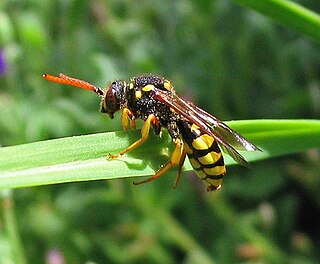
With over 850 species, the genus Nomada is one of the largest genera in the family Apidae, and the largest genus of cuckoo bees. Cuckoo bees are so named because they enter the nests of a host and lay eggs there, stealing resources that the host has already collected. The name "Nomada" is derived from the Greek word nomas, meaning "roaming" or "wandering."
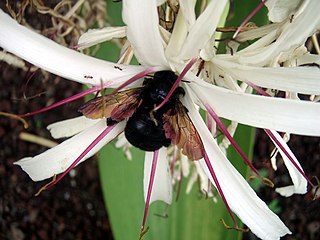
Xylocopa sonorina, the valley carpenter bee or Hawaiian carpenter bee, is a species of carpenter bee found from western Texas to northern California, and the eastern Pacific islands. Females are black while males are golden-brown with green eyes.

Colletes hederae, the ivy bee, is a species of plasterer bee belonging to the family Colletidae subfamily Colletinae.
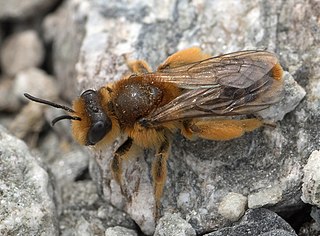
Leioproctus fulvescens is a species of solitary bee belonging to the family Colletidae. This bee is endemic to the South Island of New Zealand, and its yellow-orange hair distinguishes it from all other New Zealand species of Leioproctus.

The Oriental carpenter bee, Xylocopa nasalis, or Xylocopa (Biluna) nasalis, is a species of carpenter bee. It is widely distributed in Southeast Asian countries. It is a major pollinator within its ecosystem, and is often mistaken for a bumblebee. The species leads a solitary lifestyle with a highly female-biased colony in the nest.
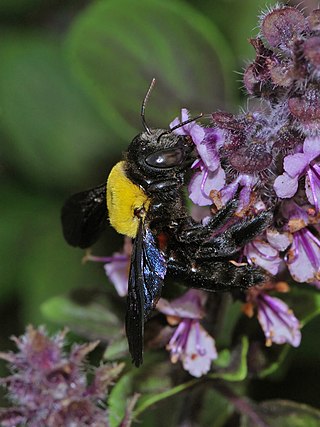
Xylocopa pubescens is a species of large carpenter bee. Females form nests by excavation with their mandibles, often in dead or soft wood. X. pubescens is commonly found in areas extending from India to Northeast and West Africa. It must reside in these warm climates because it requires a minimum ambient temperature of 18 °C (64 °F) in order to forage.

Macropis nuda is a ground nesting, univoltine bee native to northern parts of North America. Thus, this species cocoons as pupae and hibernates over the winter. The species is unusual as it is an oligolectic bee, foraging exclusively for floral oils and pollen from Primulaceae of the species Lysimachia ciliata.

Colletes halophilus, the sea aster mining bee, is a rare species of mining bee from the family Colletidae which is found around the margins of saltmarsh and other coastal habitats in south-eastern England and north-western Europe. It is threatened by rising sea levels and human development which reduce its food plant sea aster and destroy its nesting areas.

Colletes succinctus, the common colletes or heather colletes, is a species of Palearctic mining bee from the family Colletidae. It is part of the succinctus species group within the genus Colletes and is especially closely related to the ivy bee and the sea aster mining bee which are partially sympatric with C. succinctus but ecologically separate.

Stenoria analis, the ivy bee blister beetle, is a species of blister beetle from the family Meloidae which is found in western Europe and North Africa and is a specialist cleptoparasite of the ivy bee larvae. Its occurrence in regions outside of the known range of the ivy bee, for example in North Africa, suggest that it has other hosts.

Lasioglossum sordidum, also referred to as the small native bee, is one of the smallest native bees found in New Zealand.
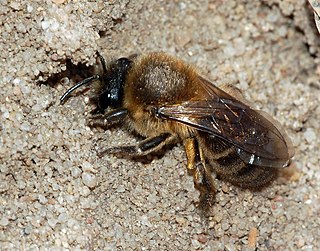
Colletes cunicularius, the vernal colletes or spring mining bee, is a species of solitary bee from the family Colletidae which is widespread in the Palearctic from Britain to the Pacific Ocean which nests in areas of open, sandy soil.
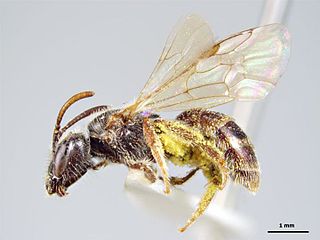
Lasioglossum mataroa is a bee species that is found in New Zealand.
























